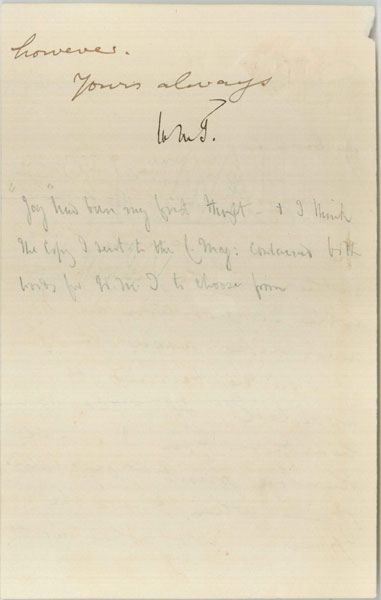Written by Melinda Creech, Graduate Assistant, Armstrong Browning Library
William Makepeace Thackeray is most remembered for his satiric novel Vanity Fair (1847-48). He also became editor of the very successful Cornhill magazine in 1860. Although during the nineteenth century Thackeray’s popularity ranked second only to Dickens, today he is much less read and is known almost exclusively for Vanity Fair.
The Armstrong Browning Library holds thirteen letters written by Thackeray and over sixty books authored by Thackeray, some rare or copies of editions the Brownings had in their library.
The letters and books below give a glimpse into Thackeray’s work as an editor for Cornhill and his relationship with Frederick Locker-Lampson. Additionally, the ABL has thirty-two Victorian letters in which Frederick Locker-Lampson is a correspondent and twelve books authored by Locker-Lampson, including two, with Locker’s signature, which were in the Brownings’ Library. There are also ten Locker-Lampson letters in the Browning Collection.
Frederick Locker-Lampson. London Lyrics. New ed., enl. and finally revised. London: Henry S. King & Co, 1876.
Locker quotes Thackeray’s opinion of his poetry in the Notes to the 1904 edition of his poetry collection, London Lyrics.
…Thackeray believed in me, and used to say, ‘Nevermind, Locker—our verse may be small beer, but at least it’s the right tap.’
Letter from William Makepeace Thackeray to Frederick Locker. 22 January 1861.
Thackeray regrets that he was not able to be present to support Locker-Lampson on the previous Saturday due to “spasm fits.” The embossed crest of the stationery is for the Garrick Club. The letter may regard Locker-Lampson’s rejection from the Garrick Club.
I hope you bear your . of Saturday equanimously. I ought to have been here to prevent it for you were only b—k b—ll—d [black balled] because there was nobody there to speak for you and there should have been such a friend.
Letter from William Makepeace Thackeray to Frederick Locker. 11 February 1861.
Thackeray asks Locker-Lampson to change the last line of his poem, “My Neighbor’s Rose,” from “And god go with her” to “And joy go with her,” claiming that:
The name of Allah jars rather in the pleasant little composition, and I never like using it if it can be turned or avoided.
Letter from William Makepeace Thackeray to Frederick Locker. No date.
This letter contains the first stanza of Locker’s poem, “A Human Skull,” with Thackeray’s correction. The poem was Locker’s first contribution to Cornhill, published December 1860. The letter on the verso reads:
My dear L.
that isn’t a good verse—I have mislaid proof 1. –will you recorrect please—and what do you think of the 4 lines on t’other side.








